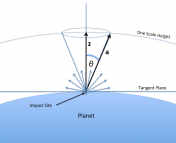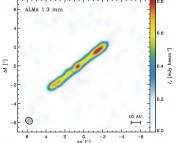Title: Terrestrial planets across space and time
Authors: Erik Zackrisson, Per Calissendorff, Juan González, Andrew Benson, Anders Johansen, and Markus Janson
First Author’s Affiliation: Uppsala University, Sweden
Paper status: Submitted for review
When I was born in 1989, there were just nine planets known throughout the entire universe (poor Pluto). Now there are between 1600 and 2100 confirmed exoplanets (depending on whom you ask). All these planets are located in a small region of our home galaxy (the Milky Way). However, there are billions of other galaxies. Therefore, you might ask just how many do we expect throughout the entire universe? This paper attempts to create a “cosmic inventory” of terrestrial (rocky) planets by combining the fields of cosmology, galaxy formation, and exoplanet science to estimate the number of planets around FGKM stars. (To distinguish stars of different masses, astronomers give them different letters. The pneumonic, from most massive stars to least massive, is “Oh Be A Fine Girl/Guy, Kiss Me”. For reference, the Sun is a G-dwarf star.)
The Recipe
The most direct ingredient that goes into the recipe for the cosmic inventory of exoplanets is the material out of which planets form. Elements heavier than hydrogen and helium are the most important because they can create the solid material to build up planets. These elements are called “metals” (yes, even elements like oxygen and neon). The amount of metals in an object is called its metallicity. Planet-forming regions around newborn stars (called protoplanetary disks) are likely to form more large, gas giant planets if the disk has a high metallicity. This is because there’s more solid material around to clump together early when there is still a lot of gas around to capture. These massive planets get jostled around by each other during the early stages of planet formation and might toss out some of the small, rocky planets that might also form in the system. On the other hand, if you have too little metal in your protoplanetary disk, you might not have enough solid material to even make a terrestrial planet in the first place. This leads to a Goldilocks-style “not too much, not too little” scenario for metallicity. All of this metallicity-dependence is added to our recent knowledge of how many and what kind of planets form around what kind of stars, which is based on the ~2000 planets astronomers have already discovered.
So now that we have a model for how to make planets around stars, we have to create the stars and the galaxies they live in. The authors use what are called semi-analytic models to do this, which are basically simple galaxy evolution models tuned to fit our observations of galaxies both now and in the past. (As you look farther away, you are also looking farther back in time, so we know how galaxies looked like when they were much younger.) These semi-analytic models are a quick way to model a representative sample volume of the universe without spending years running a simulation. These models show galaxies growing and evolving, and they can track the births, deaths, and properties of stars, such as their masses, ages, and metallicities. The authors then tack on their planet formation model on top of it all to calculate the number and types of planets that orbit all these different types of stars in all of the galaxies.
The Cosmic Inventory
The average age of terrestrial planets in the local universe is calculated to be 8.1 Gyr old. The oldest planets are found in the largest galaxies because, since the largest galaxies formed earlier, planets were also allowed to form earlier. Some of the more massive stars with terrestrial planets have already died out, taking their planets with them as they went. However, since stars <0.95 times the mass of the Sun have lifetimes longer than the current age of the universe, this does not affect the majority of stars. In all, about 15% of all terrestrial planets have been lost due to the deaths of their host stars.

The average age of a planet orbiting FGKM stars (black) and FGK stars (blue) as a function of the (logarithmic) mass of its host galaxy. More massive galaxies host older planets, and for smaller galaxies, the planets orbiting M-dwarfs are typically a bit younger than the planets orbiting FGK stars.
The authors’ model also makes a strong prediction that about 1/3 of all terrestrial planets should be orbiting stars that are either more metal-rich or (more likely) more metal-poor than any planet-hosting star we currently know of. Another noteworthy estimate is that they calculate that a Milky Way-like galaxy should have about 100 billion terrestrial planets around M-dwarfs, but only 2 billion stars around more Sun-like FGK stars. This is in line with several other papers claiming that the number of planets orbiting M-dwarfs vastly outnumbers those orbiting Sun-like stars.
So what’s the total number of the cosmic inventory of terrestrial planets for the entire universe? The authors estimate that the entire observable universe has terrestrial planets, 98% of which are orbiting M-dwarfs. This fact is why many research groups all around the globe have shifted their attention to M-dwarfs in the search for more rocky planets.





Thanks for sharing your insights about the cosmic inventory of terrestrial planets for the entire universe. Very interesting topic to read on. Keep it up!